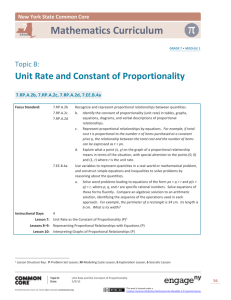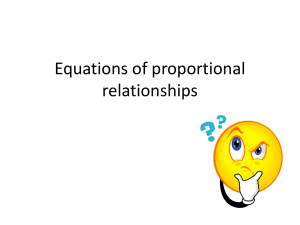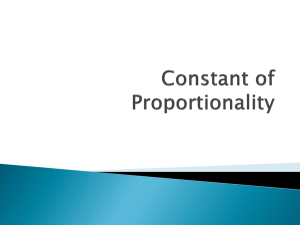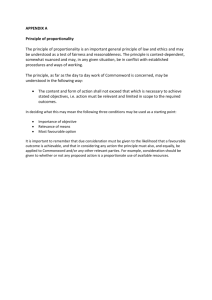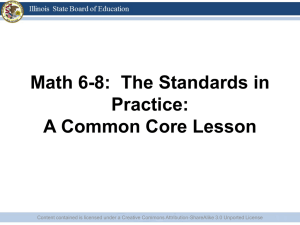Lesson 8: Representing Proportional Relationships with Equations
advertisement
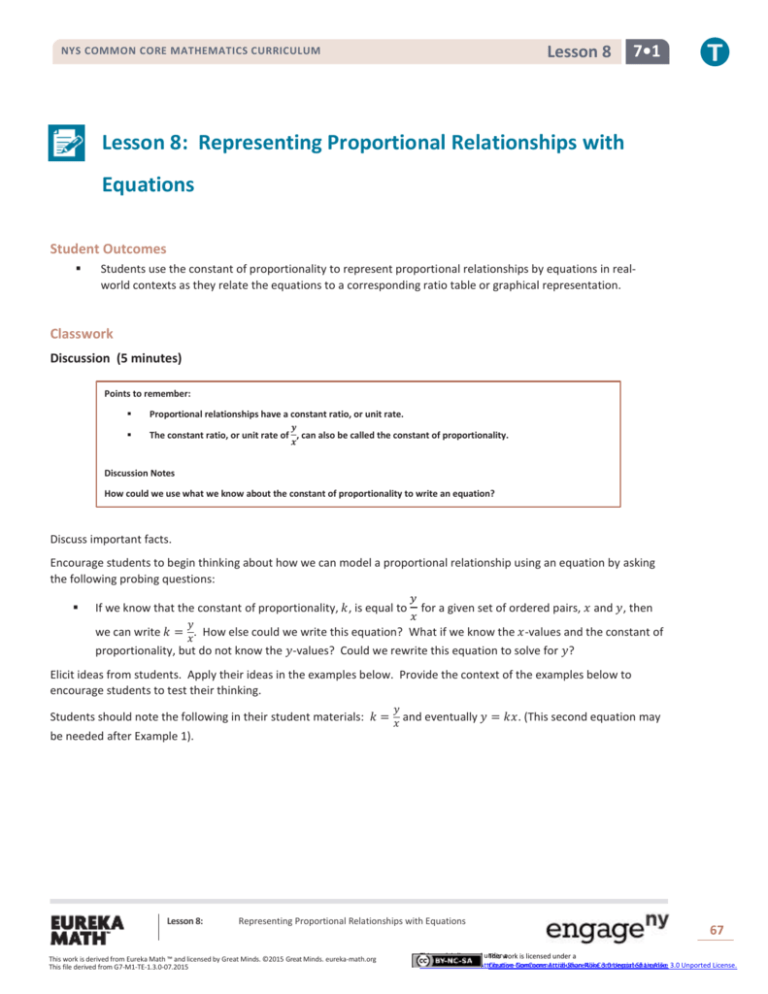
Lesson 8 NYS COMMON CORE MATHEMATICS CURRICULUM 7•1 Lesson 8: Representing Proportional Relationships with Equations Student Outcomes Students use the constant of proportionality to represent proportional relationships by equations in realworld contexts as they relate the equations to a corresponding ratio table or graphical representation. Classwork Discussion (5 minutes) Points to remember: Proportional relationships have a constant ratio, or unit rate. The constant ratio, or unit rate of , can also be called the constant of proportionality. 𝒚 𝒙 Discussion Notes How could we use what we know about the constant of proportionality to write an equation? Discuss important facts. Encourage students to begin thinking about how we can model a proportional relationship using an equation by asking the following probing questions: If we know that the constant of proportionality, 𝑘, is equal to 𝑦 𝑥 𝑦 𝑥 for a given set of ordered pairs, 𝑥 and 𝑦, then we can write 𝑘 = . How else could we write this equation? What if we know the 𝑥-values and the constant of proportionality, but do not know the 𝑦-values? Could we rewrite this equation to solve for 𝑦? Elicit ideas from students. Apply their ideas in the examples below. Provide the context of the examples below to encourage students to test their thinking. Students should note the following in their student materials: 𝑘 = 𝑦 and eventually 𝑦 = 𝑘𝑥. (This second equation may 𝑥 be needed after Example 1). Lesson 8: Representing Proportional Relationships with Equations This work is derived from Eureka Math ™ and licensed by Great Minds. ©2015 Great Minds. eureka-math.org This file derived from G7-M1-TE-1.3.0-07.2015 67 This work is licensed under a This work is licensed under a Creative Commons Attribution-NonCommercial-ShareAlike 3.0 Unported License. 3.0 Unported License. Creative Commons Attribution-NonCommercial-ShareAlike Lesson 8 NYS COMMON CORE MATHEMATICS CURRICULUM 7•1 Examples 1–2 (33 minutes) MP.2 Write an equation that will model the real-world situation. Example 1: Do We Have Enough Gas to Make It to the Gas Station? Your mother has accelerated onto the interstate beginning a long road trip, and you notice that the low fuel light is on, indicating that there is a half a gallon left in the gas tank. The nearest gas station is 𝟐𝟔 miles away. Your mother keeps a log where she records the mileage and the number of gallons purchased each time she fills up the tank. Use the information in the table below to determine whether you will make it to the gas station before the gas runs out. You know that if you can determine the amount of gas that her car consumes in a particular number of miles, then you can determine whether or not you can make it to the next gas station. Mother’s Gas Record Gallons 𝟖 𝟏𝟎 𝟒 a. Miles Driven 𝟐𝟐𝟒 𝟐𝟖𝟎 𝟏𝟏𝟐 Find the constant of proportionality, and explain what it represents in this situation. Gallons Miles Driven 𝟖 𝟐𝟐𝟒 𝟏𝟎 𝟐𝟖𝟎 𝟒 𝟏𝟏𝟐 𝟐𝟐𝟒 = 𝟐𝟖 𝟖 𝟐𝟖𝟎 = 𝟐𝟖 𝟏𝟎 𝟏𝟏𝟐 = 𝟐𝟖 𝟒 The constant of proportionality, 𝒌, is 𝟐𝟖. The car travels 𝟐𝟖 miles for every one gallon of gas. b. Write equation(s) that will relate the miles driven to the number of gallons of gas. 𝒚 = 𝟐𝟖𝒙 or 𝒎 = 𝟐𝟖𝒈 c. Knowing that there is a half gallon left in the gas tank when the light comes on, will she make it to the nearest gas station? Explain why or why not. No, she will not make it because she gets 𝟐𝟖 miles to one gallon. Since she has 𝟏 𝟐 gallon remaining in the gas tank, she can travel 𝟏𝟒 miles. Since the nearest gas station is 𝟐𝟔 miles away, she will not have enough gas. d. Using the equation found in part (b), determine how far your mother can travel on 𝟏𝟖 gallons of gas. Solve the problem in two ways: once using the constant of proportionality and once using an equation. Using arithmetic: 𝟐𝟖(𝟏𝟖) = 𝟓𝟎𝟒 Using an equation: 𝒎 = 𝟐𝟖𝒈 𝒎 = 𝟐𝟖(𝟏𝟖) – Use substitution to replace the 𝒈 (gallons of gas) with 𝟏𝟖. – This is the same as multiplying by the constant of proportionality. 𝒎 = 𝟓𝟎𝟒 Your mother can travel 𝟓𝟎𝟒 miles on 𝟏𝟖 gallons of gas. Lesson 8: Representing Proportional Relationships with Equations This work is derived from Eureka Math ™ and licensed by Great Minds. ©2015 Great Minds. eureka-math.org This file derived from G7-M1-TE-1.3.0-07.2015 68 This work is licensed under a This work is licensed under a Creative Commons Attribution-NonCommercial-ShareAlike 3.0 Unported License. 3.0 Unported License. Creative Commons Attribution-NonCommercial-ShareAlike Lesson 8 NYS COMMON CORE MATHEMATICS CURRICULUM e. 7•1 Using the constant of proportionality, and then the equation found in part (b), determine how many gallons of gas would be needed to travel 𝟕𝟓𝟎 miles. Using arithmetic: 𝟕𝟓𝟎 𝟐𝟖 = 𝟐𝟔. 𝟖 Using algebra: – Use substitution to replace the 𝒎 (miles driven) with 𝟕𝟓𝟎. 𝒎 = 𝟐𝟖𝒈 𝟕𝟓𝟎 = 𝟐𝟖𝒈 𝟏 𝟏 ( ) 𝟕𝟓𝟎 = ( ) 𝟐𝟖𝒈 𝟐𝟖 𝟐𝟖 𝟐𝟔. 𝟖 = 𝟏𝒈 – This equation demonstrates dividing by the constant of proportionality or using the multiplicative inverse to solve the equation. 𝟐𝟔. 𝟖 (rounded to the nearest tenth) gallons would be needed to drive 𝟕𝟓𝟎 miles. Have students write the pairs of numbers in the chart as ordered pairs. Explain that in this example, 𝑥 represents the number of gallons of gas, and 𝑦 represents the number of miles driven. Remind students to think of the constant of 𝑦 proportionality as 𝑘 = . In this case, the constant of proportionality is a certain number of miles divided by a certain 𝑥 number of gallons of gas. This constant is the same as the unit rate of miles per gallon of gas. Remind students that you will use the constant of proportionality (or unit rate) as a multiplier in your equation. Write equation(s) that will relate the miles driven to the number of gallons of gas. In order to write the equation to represent this situation, direct students to think of the independent and dependent variables that are implied in this problem. Which part depends on the other for its outcome? The number of miles driven depends on the number of gallons of gas that are in the gas tank. Which is the dependent variable: the number of gallons of gas or the amount of miles driven? The number of miles driven is the dependent variable, and the number of gallons of gas is the independent variable. Tell students that 𝑥 is usually known as the independent variable, and 𝑦 is known as the dependent variable. Remind students that the constant of proportionality can also be expressed as 𝑦 𝑥 from an ordered pair. It is the value of the ratio of the dependent variable to the independent variable. When 𝑥 and 𝑦 are graphed on a coordinate plane, which axis would show the values of the dependent variable? 𝑦-axis The independent variable? 𝑥-axis Tell students that any variable may be used to represent the situation as long as it is known that in showing a proportional relationship in an equation that the constant of proportionality is multiplied by the independent variable. In this problem, students can write 𝑦 = 28𝑥, or 𝑚 = 28𝑔. We are substituting 𝑘 with 28 in the equation 𝑦 = 𝑘𝑥, or 𝑚 = 𝑘𝑔. Tell students that this equation models the situation and provides them with a way to determine either variable when the other is known. If the equation is written so a variable can be substituted with the known information, then students can use algebra to solve the equation. Lesson 8: Representing Proportional Relationships with Equations This work is derived from Eureka Math ™ and licensed by Great Minds. ©2015 Great Minds. eureka-math.org This file derived from G7-M1-TE-1.3.0-07.2015 69 This work is licensed under a This work is licensed under a Creative Commons Attribution-NonCommercial-ShareAlike 3.0 Unported License. 3.0 Unported License. Creative Commons Attribution-NonCommercial-ShareAlike Lesson 8 NYS COMMON CORE MATHEMATICS CURRICULUM 7•1 Example 2: Andrea’s Portraits Andrea is a street artist in New Orleans. She draws caricatures (cartoon-like portraits) of tourists. People have their portrait drawn and then come back later to pick it up from her. The graph below shows the relationship between the number of portraits she draws and the amount of time in hours she needs to draw the portraits. a. Write several ordered pairs from the graph, and explain what each ordered pair means in the context of this graph. (𝟒, 𝟔) means that in 𝟒 hours, she can draw 𝟔 portraits. (𝟔, 𝟗) means that in 𝟔 hours, she can draw 𝟗 portraits. (𝟐, 𝟑) means that in 𝟐 hours, she can draw 𝟑 portraits. 𝟏 𝟐 𝟏 𝟐 (𝟏, 𝟏 ) means that in 𝟏 hour, she can draw 𝟏 portraits. b. Write several equations that would relate the number of portraits drawn to the time spent drawing the portraits. 𝟑 𝑻 𝟐 𝟔 𝑵= 𝑻 𝟒 𝟗 𝑵= 𝑻 𝟔 𝑵= c. 𝟏 𝟑 𝟔 𝟗 𝟏𝟐 = = = 𝟐 𝟒 𝟔 𝟏 Determine the constant of proportionality, and explain what it means in this situation. 𝟑 The constant of proportionality is , which means that Andrea can draw 𝟑 portraits in 𝟐 hours or can 𝟐 𝟏 𝟐 complete 𝟏 portraits in 𝟏 hour. Tell students that these ordered pairs can be used to generate the constant of proportionality, and write the equation 𝑦 for this situation. Remember that = . 𝑥 Lesson 8: Representing Proportional Relationships with Equations This work is derived from Eureka Math ™ and licensed by Great Minds. ©2015 Great Minds. eureka-math.org This file derived from G7-M1-TE-1.3.0-07.2015 70 This work is licensed under a This work is licensed under a Creative Commons Attribution-NonCommercial-ShareAlike 3.0 Unported License. 3.0 Unported License. Creative Commons Attribution-NonCommercial-ShareAlike Lesson 8 NYS COMMON CORE MATHEMATICS CURRICULUM 7•1 Closing (2 minutes) How can unit rate be used to write an equation relating two variables that are proportional? The unit rate of 𝑦 𝑥 is the constant of proportionality, 𝑘. After computing the value for 𝑘, it may be substituted in place of 𝑘 in the equation 𝑦 = 𝑘𝑥. The constant of proportionality can be multiplied by the independent variable to find the dependent variable, and the dependent variable can be divided by the constant of proportionality to find the independent variables. Lesson Summary If a proportional relationship is described by the set of ordered pairs that satisfies the equation 𝒚 = 𝒌𝒙, where 𝒌 is a positive constant, then 𝒌 is called the constant of proportionality. The constant of proportionality expresses the multiplicative relationship between each 𝒙-value and its corresponding 𝒚-value. Exit Ticket (5 minutes) Lesson 8: Representing Proportional Relationships with Equations This work is derived from Eureka Math ™ and licensed by Great Minds. ©2015 Great Minds. eureka-math.org This file derived from G7-M1-TE-1.3.0-07.2015 71 This work is licensed under a This work is licensed under a Creative Commons Attribution-NonCommercial-ShareAlike 3.0 Unported License. 3.0 Unported License. Creative Commons Attribution-NonCommercial-ShareAlike Lesson 8 NYS COMMON CORE MATHEMATICS CURRICULUM Name 7•1 Date Lesson 8: Representing Proportional Relationships with Equations Exit Ticket John and Amber work at an ice cream shop. The hours worked and wages earned are given for each person. John’s Wages Time Wages (in hours) (in dollars) 1. 2 18 3 27 4 36 Determine if John’s wages are proportional to time. If they are, determine the unit rate of 𝑦 𝑥 . If not, explain why they are not. Lesson 8: Representing Proportional Relationships with Equations This work is derived from Eureka Math ™ and licensed by Great Minds. ©2015 Great Minds. eureka-math.org This file derived from G7-M1-TE-1.3.0-07.2015 72 This work is licensed under a This work is licensed under a Creative Commons Attribution-NonCommercial-ShareAlike 3.0 Unported License. 3.0 Unported License. Creative Commons Attribution-NonCommercial-ShareAlike Lesson 8 NYS COMMON CORE MATHEMATICS CURRICULUM 2. 7•1 𝑦 Determine if Amber’s wages are proportional to time. If they are, determine the unit rate of . If not, explain why 𝑥 they are not. 3. Write an equation for both John and Amber that models the relationship between their wage and the time they worked. Identify the constant of proportionality for each. Explain what it means in the context of the situation. 4. How much would each worker make after working 10 hours? Who will earn more money? 5. How long will it take each worker to earn $50? Lesson 8: Representing Proportional Relationships with Equations This work is derived from Eureka Math ™ and licensed by Great Minds. ©2015 Great Minds. eureka-math.org This file derived from G7-M1-TE-1.3.0-07.2015 73 This work is licensed under a This work is licensed under a Creative Commons Attribution-NonCommercial-ShareAlike 3.0 Unported License. 3.0 Unported License. Creative Commons Attribution-NonCommercial-ShareAlike Lesson 8 NYS COMMON CORE MATHEMATICS CURRICULUM 7•1 Exit Ticket Sample Solutions John and Amber work at an ice cream shop. The hours worked and wages earned are given for each person. 𝟏𝟔 =𝟖 𝟐 John’s Wages Time Wages (in hours) (in dollars) 1. 𝟐 𝟏𝟖 𝟑 𝟐𝟕 𝟒 𝟑𝟔 𝟖 =𝟖 𝟏 𝟏𝟖 =𝟗 𝟐 𝟐𝟕 =𝟗 𝟑 𝟑𝟔 =𝟗 𝟒 𝒚 Determine if John’s wages are proportional to time. If they are, determine the unit rate of . If not, explain why 𝒙 they are not. Yes, the unit rate is 𝟗. The collection of ratios is equivalent. 2. 𝒚 Determine if Amber’s wages are proportional to time. If they are, determine the unit rate of . If not, explain why 𝒙 they are not. Yes, the unit rate is 𝟖. The collection of ratios is equivalent. 3. Write an equation for both John and Amber that models the relationship between their wage and the time they worked. Identify the constant of proportionality for each. Explain what it means in the context of the situation. John: 𝒘 = 𝟗𝒉; the constant of proportionality is 𝟗; John earns $𝟗 for every hour he works. Amber: 𝒘 = 𝟖𝒉; the constant of proportionality is 𝟖; Amber earns $𝟖 for every hour she works. 4. How much would each worker make after working 𝟏𝟎 hours? Who will earn more money? After 𝟏𝟎 hours, John will earn $𝟗𝟎 because 𝟏𝟎 hours is the value of the independent variable, which should be multiplied by 𝒌, the constant of proportionality. 𝒘 = 𝟗𝒉; 𝒘 = 𝟗(𝟏𝟎); 𝒘 = 𝟗𝟎. After 𝟏𝟎 hours, Amber will earn $𝟖𝟎 because her equation is 𝒘 = 𝟖𝒉; 𝒘 = 𝟖(𝟏𝟎); 𝒘 = 𝟖𝟎. John will earn more money than Amber in the same amount of time. 5. How long will it take each worker to earn $𝟓𝟎? To determine how long it will take John to earn $𝟓𝟎, the dependent value will be divided by 𝟗, the constant of proportionality. Algebraically, this can be shown as a one-step equation: 𝟓𝟎 = 𝟗𝒉; ( 𝟓𝟎 𝟗 𝟏 ) 𝟓𝟎 = 𝟗 𝟏 𝟗 ( ) 𝟗𝒉; = 𝟏 𝒉; 𝟓. 𝟓𝟔 = 𝒉 (round to the nearest hundredth). It will take John nearly 𝟔 hours to earn $𝟓𝟎. To find how long it will take Amber to earn $𝟓𝟎, divide by 𝟖, the constant of proportionality. 𝟓𝟎 = 𝟖𝒉; 𝟏 𝟖 𝟏 𝟖 ( ) 𝟓𝟎 = ( ) 𝟖𝒉; Lesson 8: 𝟓𝟎 𝟖 = 𝟏𝒉; 𝟔. 𝟐𝟓 = 𝒉. It will take Amber 𝟔. 𝟐𝟓 hours to earn $𝟓𝟎. Representing Proportional Relationships with Equations This work is derived from Eureka Math ™ and licensed by Great Minds. ©2015 Great Minds. eureka-math.org This file derived from G7-M1-TE-1.3.0-07.2015 74 This work is licensed under a This work is licensed under a Creative Commons Attribution-NonCommercial-ShareAlike 3.0 Unported License. 3.0 Unported License. Creative Commons Attribution-NonCommercial-ShareAlike Lesson 8 NYS COMMON CORE MATHEMATICS CURRICULUM 7•1 Problem Set Sample Solutions Write an equation that will model the proportional relationship given in each real-world situation. 1. There are 𝟑 cans that store 𝟗 tennis balls. Consider the number of balls per can. a. Find the constant of proportionality for this situation. 𝟗 balls (𝑩) balls =𝟑 𝟑 cans (𝑪) can The constant of proportionality is 𝟑. b. Write an equation to represent the relationship. 𝑩 = 𝟑𝑪 2. In 𝟐𝟓 minutes, Li can run 𝟏𝟎 laps around the track. Determine the number of laps she can run per minute. a. Find the constant of proportionality in this situation. 𝟏𝟎 laps (𝑳) 𝟐 laps = 𝟐𝟓 minutes (𝑴) 𝟓 minute 𝟐 The constant of proportionality is . 𝟓 b. Write an equation to represent the relationship. 𝑳= 3. 𝟐 𝑴 𝟓 Jennifer is shopping with her mother. They pay $𝟐 per pound for tomatoes at the vegetable stand. a. Find the constant of proportionality in this situation. 𝟐 dollars (𝑫) dollars =𝟐 𝟏 pound (𝑷) pound The constant of proportionality is 𝟐. b. Write an equation to represent the relationship. 𝑫 = 𝟐𝑷 4. It costs $𝟏𝟓 to send 𝟑 packages through a certain shipping company. Consider the number of packages per dollar. a. Find the constant of proportionality for this situation. 𝟑 packages (𝑷) 𝟑 packages = 𝟏𝟓 dollars (𝑫) 𝟏𝟓 dollar 𝟏 The constant of proportionality is . 𝟓 b. Write an equation to represent the relationship. 𝑷= 𝟏 𝑫 𝟓 Lesson 8: Representing Proportional Relationships with Equations This work is derived from Eureka Math ™ and licensed by Great Minds. ©2015 Great Minds. eureka-math.org This file derived from G7-M1-TE-1.3.0-07.2015 75 This work is licensed under a This work is licensed under a Creative Commons Attribution-NonCommercial-ShareAlike 3.0 Unported License. 3.0 Unported License. Creative Commons Attribution-NonCommercial-ShareAlike Lesson 8 NYS COMMON CORE MATHEMATICS CURRICULUM 5. 7•1 On average, Susan downloads 𝟔𝟎 songs per month. An online music vendor sells package prices for songs that can be downloaded onto personal digital devices. The graph below shows the package prices for the most popular promotions. Susan wants to know if she should buy her music from this company or pay a flat fee of $𝟓𝟖. 𝟎𝟎 per month offered by another company. Which is the better buy? Number of Songs Purchased (S) Total Cost (C) 𝟒𝟎 𝟑𝟔 𝟐𝟎 𝟏𝟖 𝟏𝟐 𝟏𝟎. 𝟖𝟎 𝟓 𝟒. 𝟓𝟎 a. Constant of Proportionality 𝟑𝟔 𝟗 = = 𝟎. 𝟗 𝟒𝟎 𝟏𝟎 𝟏𝟖 𝟗 = = 𝟎. 𝟗 𝟐𝟎 𝟏𝟎 𝟏𝟎. 𝟖𝟎 𝟗 = = 𝟎. 𝟗 𝟏𝟐 𝟏𝟎 𝟒. 𝟓𝟎 𝟗 = = 𝟎. 𝟗 𝟓 𝟏𝟎 Find the constant of proportionality for this situation. The constant of proportionality, 𝒌, is 𝟎. 𝟗. b. Write an equation to represent the relationship. 𝑪 = 𝟎. 𝟗𝑺 x c. Use your equation to find the answer to Susan’s question above. Justify your answer with mathematical evidence and a written explanation. Compare the flat fee of $𝟓𝟖 per month to $𝟎. 𝟗𝟎 per song. If 𝑪 = 𝟎. 𝟗𝑺 and we substitute 𝑺 with 𝟔𝟎 (the number of songs), then the result is 𝑪 = 𝟎. 𝟗(𝟔𝟎) = 𝟓𝟒. She would spend $𝟓𝟒 on songs if she bought 𝟔𝟎 songs. If she maintains the same number of songs, the charge of $𝟎. 𝟗𝟎 per song would be cheaper than the flat fee of $𝟓𝟖 per month. 6. Allison’s middle school team has designed t-shirts containing their team name and color. Allison and her friend Nicole have volunteered to call local stores to get an estimate on the total cost of purchasing t-shirts. Print-o-Rama charges a set-up fee, as well as a fixed amount for each shirt ordered. The total cost is shown below for the given number of shirts. Value T’s and More charges $𝟖 per shirt. Which company should they use? Print-o-Rama Number of Total Cost Shirts (S) (C) 𝟏𝟎 𝟗𝟓 𝟐𝟓 𝟓𝟎 𝟑𝟕𝟓 𝟕𝟓 𝟏𝟎𝟎 Lesson 8: Representing Proportional Relationships with Equations This work is derived from Eureka Math ™ and licensed by Great Minds. ©2015 Great Minds. eureka-math.org This file derived from G7-M1-TE-1.3.0-07.2015 76 This work is licensed under a This work is licensed under a Creative Commons Attribution-NonCommercial-ShareAlike 3.0 Unported License. 3.0 Unported License. Creative Commons Attribution-NonCommercial-ShareAlike Lesson 8 NYS COMMON CORE MATHEMATICS CURRICULUM a. 7•1 Does either pricing model represent a proportional relationship between the quantity of t-shirts and the total cost? Explain. The unit rate of 𝒚 𝒙 for Print-o-Rama is not constant. The graph for Value T’s and More is proportional since the ratios are equivalent (𝟖) and the graph shows a line through the origin. b. Write an equation relating cost and shirts for Value T’s and More. 𝑪 = 𝟖𝑺 for Value T’s and More c. What is the constant of proportionality of Value T’s and More? What does it represent? 𝟖; the cost of one shirt is $𝟖. d. How much is Print-o-Rama’s set-up fee? The set-up fee is $𝟐𝟓. e. If you need to purchase 𝟗𝟎 shirts, write a proposal to your teacher indicating which company the team should use. Be sure to support your choice. Determine the number of shirts that you need for your team. Since we plan on a purchase of 𝟗𝟎 shirts, we should choose Print-o-Rama. Print-o-Rama: 𝑪 = 𝟕𝑺 + 𝟐𝟓; 𝑪 = 𝟕(𝟗𝟎) + 𝟐𝟓; 𝑪 = 𝟔𝟓𝟓 Value T’s and More: 𝑪 = 𝟖𝑺; 𝑪 = 𝟖(𝟗𝟎); 𝑪 = 𝟕𝟐𝟎 Lesson 8: Representing Proportional Relationships with Equations This work is derived from Eureka Math ™ and licensed by Great Minds. ©2015 Great Minds. eureka-math.org This file derived from G7-M1-TE-1.3.0-07.2015 77 This work is licensed under a This work is licensed under a Creative Commons Attribution-NonCommercial-ShareAlike 3.0 Unported License. 3.0 Unported License. Creative Commons Attribution-NonCommercial-ShareAlike

